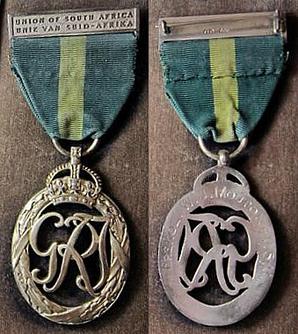Efficiency Decoration (South Africa) facts for kids
Quick facts for kids Efficiency Decoration (South Africa) |
|
|---|---|

The second version of the medal, with King George V's initials.
|
|
| Presented by | The Monarch of the United Kingdom and the British Dominions, and Emperor of India |
| Country | |
The Efficiency Decoration (South Africa) was a special medal given to part-time military officers in South Africa. These officers were part of the Citizen Force, meaning they had regular jobs but also served in the country's defense forces. The medal was a way to thank them for their long and dedicated service.
This award was created in 1930. People who received it could put the letters ED after their name. In 1952, this medal was replaced by a new one called the John Chard Decoration.
Contents
How the Medal Was Created
Before 1930, officers in South Africa and other parts of the British Empire received a medal called the Colonial Auxiliary Forces Officers' Decoration. In 1892, a similar award called the Volunteer Officers' Decoration was first made for officers in the United Kingdom.
On September 23, 1930, the King of the United Kingdom created the Efficiency Decoration. It was for part-time officers in the United Kingdom and across the British Empire, including South Africa. This new medal replaced the older ones.
Each country had its name on the medal's bar. The South African version was special because it was the only one with the country's name written in two languages: English and Afrikaans. There was also a similar award for soldiers who were not officers, called the Efficiency Medal (South Africa).
Who Could Earn the Medal?
To get this medal, an officer in the Citizen Force had to serve for 20 years. They had to be seen as a skilled and capable leader. The 20 years of service did not have to be all in a row.
Here are some of the rules for earning the medal:
- Half of the time a person served as a regular soldier (before becoming an officer) could count towards the 20 years.
- Service during a war counted as double time.
- The medal was first for officers in the South African Army and South African Air Force.
- In 1942, when the South African Navy was formed, naval officers could also earn the medal.
In 1949, the rules changed. The time needed to earn the medal was lowered from 20 years to 12 years. After that, an officer could earn a special clasp for every extra six years they served.
What the Medal Looked Like
The medal was an oval shape with open spaces, like a frame. It was made of silver, with some parts covered in gold.
The Front of the Medal
The front of the medal had a wreath of oak leaves made of silver. In the middle was the Royal Cypher, which is the monarch's initials. Above the initials was a royal crown. Both the initials and the crown were gold.
There were three different versions of the medal, for the two kings who reigned during that time:
- King George V (first version): Had the initials "GVR" for Georgivs V Rex (George V, King).
- King George V (second version): Had the initials "GRI" for Georgivs Rex Imperator (George, King and Emperor).
- King George VI: Had the initials "GVIR" for Georgivs VI Rex (George VI, King). This version was used after he became king in 1936.
The Bar and Ribbon
The medal hung from a silver bar. On the bar, it said "UNION OF SOUTH AFRICA" and "UNIE VAN SUID-AFRIKA". The back of the medal was smooth. The officer's rank, initials, and last name were engraved around the edge.
The ribbon was dark green with a bright yellow stripe in the middle.
How the Medal Was Worn
There is a special order for wearing military medals. This is called the "order of wear." It shows which medals are more important.
When South Africa created its own set of medals in 1952, the older British medals like the Efficiency Decoration were still worn. However, they were placed after the new South African medals.
In the official order, the Efficiency Decoration (South Africa) was worn after the Colonial Auxiliary Forces Long Service Medal and before the Efficiency Medal (South Africa).
Famous Recipient
In total, 886 of these medals were awarded. One of the most famous people to receive it was:
- Field Marshal Jan Christiaan Smuts, who was a soldier and a Prime Minister of South Africa.
End of the Medal
The Efficiency Decoration (South Africa) stopped being awarded on April 6, 1952. It was replaced by the John Chard Decoration. The new medal was for both officers and other ranks in the Citizen Force who showed long and good service.

